Jun-28-21
 | | KEG: Maroczy and Janowski were among the world's elite in 1902 (especially with Lasker not playing tournaments between 1900 and 1904). In Lasker's absence, Maroczy tied for first with Pillsbury and Schlechter at Munich 1900 (Maroczy then becoming too ill to complete the playoff) and then Janowski took first (ahead of Schlechter) at Monte Carlo 1901. At the time the present game was played (Round 3 at Monte Carlo 1902), Janowski had won his first two games while Maroczy had beaten Pillsbury in Round 1 and had a bye in Round 2. It was already clear that Maroczy and Janowski would be among the leaders, and indeed Maroczy eventually won this tournament just ahead of Pillsbury and Janowski. This draw in Round 3 was quite exciting, Janowski trying hard to attack, overextended himself giving Maroczy winning chances. Janowski managed to save himself with clever play plus less than ideal play by Maroczy. 1. e4 e5
2. Nf3 Nc6
3. Bb5 a6
4. Ba4 Nf6
5. 0-0 Be7
6. Nc3
This sound alternative to what today is the usual 6. Re1 was occasionally employed by Maroczy, Janowski, Tarrasch, Schlechter, and Lasker himself. 6... d6
It is perhaps surprising that Janowski failed to play the more usual 6...b5 instead of the passive--though entirely playable--text. But have no fear, Janowski was to go on the attack in this game before long. 7. d3
Still seeking a solid position rather than seeking an advantage via 7. BxN+ and 8. d4. Maroczy probably also preferred to keep his two Bishops. 7. d4 was perhaps too presumptuous for Maroczy given the likely 7...b5 as a reply. 7... Bg4
Now back to his true style, Janowski sought complications rather than mere sterile equality with 7...0-0 or perhaps 7...b5. 8. Be3 0-0
9. Ne2
A convoluted more and surprising from the usually careful and positionally-minded Maroczy. He could have defanged any attacking notions Janowski may have had in mind with the simple 9. h3. The position was now:

click for larger view9... Nh5?!
Anyone else would have played 9...BxN to wreck the White king-side pawn structure (or 9...b5 and then 10...BxN). But Janowski, as always, was hell-bent on attacking even so formidable a defender as Maroczy. 10. Nd2
More convoluted (but still sound) play by Maroczy in lieu of the simple 10. Ng3 10... Bg5
11. BxB
This pretty much extinguishes any hope Maroczy had to obtain some advantage as White (with, perhaps, 11. h3 or 11. BxN depending on one's plan). But Maroczy, always trusting in his end-game prowess, seems to have been happy to cut down wood from his tactically gifted opponent. 11... QxB
12. f3
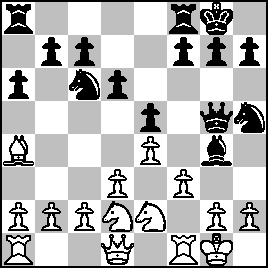
click for larger view12... Bd7
From the ultra-aggressive Janowski, one might have expected 12...Bh3. 13. Kh1
Taking precaution to an extreme degree. White could still have played 13. BxN with a reasonable game. After the text, Black had real chances to press his (still admittedly small) edge. 13... Rae8
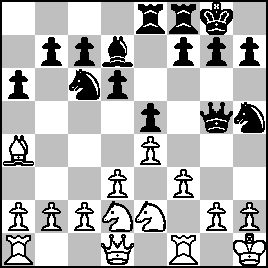
click for larger viewThe preliminaries were now over. Beginning with move 14, both players launched their respective plans and the excitement began. |
|
Jun-28-21
 | | KEG: Post II
14. g3
Intending f4. (Hoffer).
This plan, however, could have proven problematic for Maroczy. More solid were 14. Bb3 or 14. Nb1 (with c4 and Nc3 to follow). 14... Qh6
"!"--(Hoffer)
"So that if 15. f4? Bg4!" (Hoffer)
15. g4?!
This sort of attacking scheme was outside Maroczy's positionally correct style. He might have played instead 15. BxN or 15. Re1 or 15. h3. 15... Nf4
15...b5 first might also have been played by Janowski. 16. NxN QxN
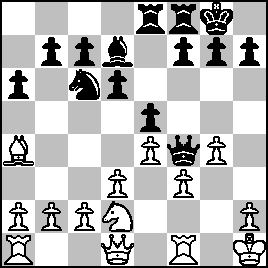
click for larger view17. Rg1
He could, and probably should, have played BxN, a move Maroczy repeatedly declined to play here (perhaps reluctant to allow Janowski to have the sole Bishop in light of the latter's well-known prowess with wielding such pieces. 17... Re6
And yet again, Janowski declined to play the indicated b5. 18. Rg3
And yet again missing a chance to play BxN.
18... Rh6
Going for the jugular.
19. Nf1 b5
Finally!
20. Bb3
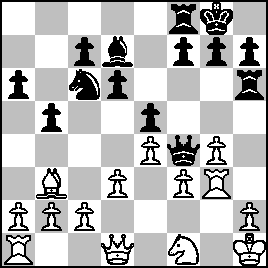
click for larger view20... Nd4
This or 20...Rh4 were the best ways for Janowski to pursue his attack. 21. c3 Ne6
22. a4
"!"--(Hoffer)
As always, Maroczy spotted chances to create play on both wings. He might also have played 22. BxN. As will be seen, the text distracted Janowski, who soon lost any advantage he had held. 
click for larger view22... Rb8
Led astray by Maroczy's last move, Janowski failed to follow up his attack with the celerity it required; here with 22...Ng5. From here, slowly and relentlessly, Maroczy outplayed Janowski and slowly but surely built what might have been a winning position. 23. axb5 Bxb5
24. BxN fxB
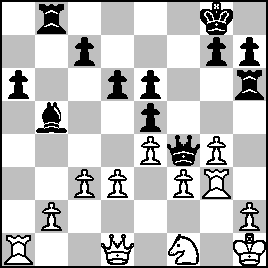
click for larger view25. g5!?
"Black's attack being spent, White commences his attack..." (Hoffer) Hoffer went on to describe White as being better here. That was a bit of an overstatement, though before long Maroczy was in the ascendency. 25... Rh4
The Tournament Book cites sources discussing 25...Rg6 and gives the following line: 26. Rg4 Qf7 27. h4 (27. Rg3 or 27. Ne3 look like simpler routes to equality--KEG) h6 after which both sides have chances. The text is certainly fine so far as I can see.
26. Qb3

click for larger viewJanowski's advantage was now a thing of the past. Beginning from this position, he seems to have lost his way for a while (time pressure?) and got into trouble. |
|
Jun-28-21
 | | KEG: Post III
26... Qf8
While not a losing move, it is hard to understand, especially from Janowski. He would still have about equal chances (and compensation for the lost pawn) after 26...Rf8 27. Qxe6+ Rf7. But this might have led to a draw by perpetual check after 28. Qc8+ Rf8, so this may have induced Janowski to keep the game alive, even at the cost of a somewhat inferior position. 27. Qxe6+ Kh8
28. Rd1
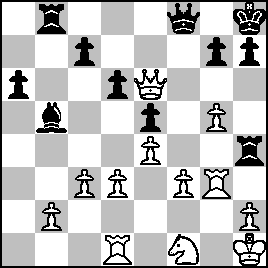
click for larger view28... Be8
Anxious for counterplay and compensation for the lost pawn, Janowski went astray here. Better chances were offered by 28...a5 or 28...Rh5. But Janowski loved to create action with his Bishops (or--as here--Bishop). 29. Rd2
Maroczy might also have tried 29. b4.
29... Bh5
30. Rf2 Rf4
31. Kg2
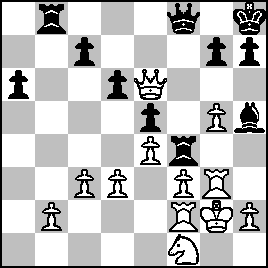
click for larger view31... Qf7
Hard to believe from Janowski, who should not have fancied playing an endgame a pawn down, especially against Maroczy. 31...a5 or 31...Qd8 were much better. 32. QxQ
Of course.
32... RxQ?
This (rather than the far superior 32...BxQ) bottled up his own Bishop and gave Maroczy very real winning chances. Had I been watching the game at the time, I would not have bet on Janowski surviving here a pawn down against one of the finest endgame players of that era (i.e., before the advent of Capablanca and Rubinstein), the position now being: 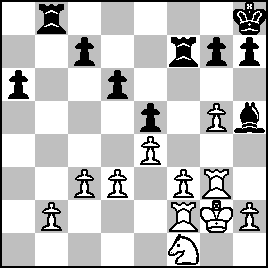
click for larger view33. Ne3
Tentative play by Maroczy. With 33. Rh3 or 33. b4, he would have had much stronger chances to win this endgame. 33... Rff8?
More weak endgame play by Janowski. He should have pounced on Maroczy's hesitation and played 33...a5. 34. Rd2?
Though Hoffer thought this was good, the way for White to make progress here was with 34. b4! Now, once again, Janowski had chances. 34... Bf7
34...Rb3 or 34...a5 were much stronger.
35. d4 exd4
36. cxd4 Rb3
This tied up Maroczy's Queen-side, but perhaps 36...Rb4 or 36...a5 were even better. 
click for larger viewIn this position, Maroczy had his final serious chance to play for a win. 37. Kf2?
37. f4 (with f5 in mind) was the way to try to press Janowski to the wall. After the text, Janowski found a way to save the game. 37... Rfb8
38. Nd1
Play could still have been a tad dicey for Black had Maroczy been willing to abandon the White pawn on b2 and press on the other wing (and follow up with a temporary Knight sacrifice) with 38. f4!, e.g., 38...Rxb2 39. Nf1 R8b4 40. Rc3 RxR+ 41. NxR Rxd4 42. Rxc7! RxN+ 43. Ke3 Rxh2 44. RxB Kg8 45. Ra7 Ra2 46. f5 with at least arguably the better chances in the Rook and pawn ending though temporarily a pawn down. But this would have been difficult to evaluate over the board (and I am far from sure about all this even with time and software at my disposal), so Maroczy's decision to defend his b2 pawn was probably the most prudent choice. But from here, Janowski was able to wind his way to a draw, the position now being: 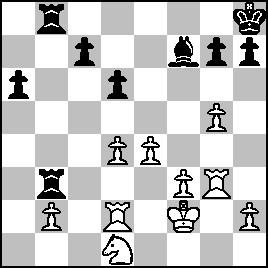
click for larger view |
|
Jun-28-21
 | | KEG: Post IV
38... Bh5
"Black maneuvered very cleverly by keeping the pressure on [White's] two weak points [the b and f pawns], and it is doubtful whether White could do more than draw in spite of the pawn ahead." (Hoffer). 39. Rh3
Maroczy seems to have been content to draw. If he had sought more, he might have tried 39. d5 (as he did a few moves later) or 39. Rc2. 39... Bg4!
40. Rg3 Bh5
41. Rh3 Bg4
42. Rg3 Bh5
Janowski might here have claimed a draw by triple repetition, as might Maroczy. When Janowski declined to claim a draw, Maroczy decided to make one final push. 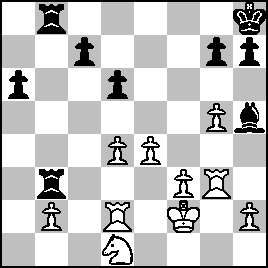
click for larger view43. d5
Hoffer claimed that 43. f4 was the only chance to avoid a draw. But after 43...BxN 44. RxB Rxb2+ a draw seems all but inevitable. The text at least kept some chances alive.
43... Rf8
44. Ne3
44. Nc3 offered slightly better, albeit slim, chances to make headway. 44... Rfb8
45. Nd1 Rf8
46. Ne3
See comment on move 44. As is evident, Maroczy was willing to repeat the position and settle for a draw. 46... Rfb8
47. Nd1
The players could again have claimed a draw by triple repetition, but chose to play on for another move. 47... Rf8
48. Ne3
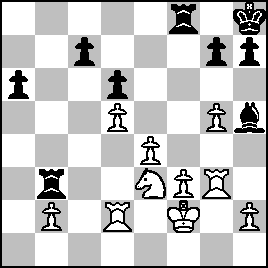
click for larger viewDrawn
Under the rules extent at Monte Carlo 1902, this draw had to be replayed with colors reversed. When the players duly squared off two days later, they drew again, and thus both settled for half a point from the two games combined. |
|
|
|
|





































